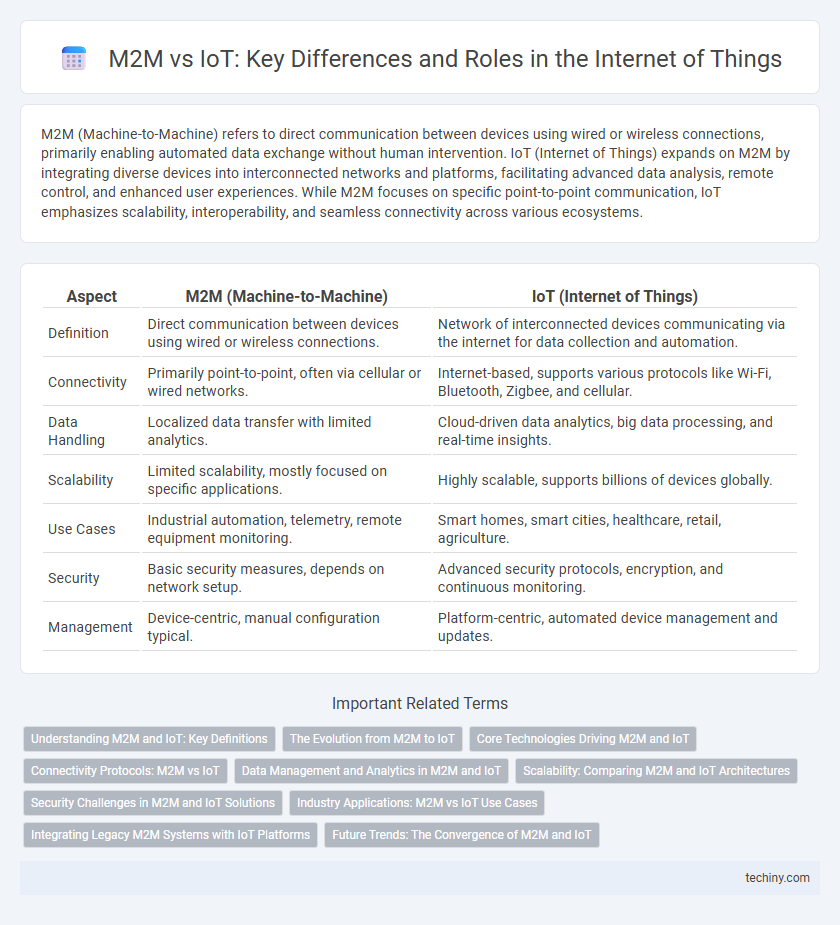M2M (Machine-to-Machine) refers to direct communication between devices using wired or wireless connections, primarily enabling automated data exchange without human intervention. IoT (Internet of Things) expands on M2M by integrating diverse devices into interconnected networks and platforms, facilitating advanced data analysis, remote control, and enhanced user experiences. While M2M focuses on specific point-to-point communication, IoT emphasizes scalability, interoperability, and seamless connectivity across various ecosystems.
Table of Comparison
| Aspect | M2M (Machine-to-Machine) | IoT (Internet of Things) |
|---|---|---|
| Definition | Direct communication between devices using wired or wireless connections. | Network of interconnected devices communicating via the internet for data collection and automation. |
| Connectivity | Primarily point-to-point, often via cellular or wired networks. | Internet-based, supports various protocols like Wi-Fi, Bluetooth, Zigbee, and cellular. |
| Data Handling | Localized data transfer with limited analytics. | Cloud-driven data analytics, big data processing, and real-time insights. |
| Scalability | Limited scalability, mostly focused on specific applications. | Highly scalable, supports billions of devices globally. |
| Use Cases | Industrial automation, telemetry, remote equipment monitoring. | Smart homes, smart cities, healthcare, retail, agriculture. |
| Security | Basic security measures, depends on network setup. | Advanced security protocols, encryption, and continuous monitoring. |
| Management | Device-centric, manual configuration typical. | Platform-centric, automated device management and updates. |
Understanding M2M and IoT: Key Definitions
M2M (Machine-to-Machine) refers to direct communication between devices using wired or wireless communication without human intervention, often within closed networks for specific industrial applications. IoT (Internet of Things) extends M2M by connecting a wider array of devices to the internet, enabling data exchange, analytics, and integration with cloud services for smarter decision-making. Understanding the distinction relies on recognizing M2M as a subset focused on device-to-device interaction, while IoT encompasses a broader ecosystem including sensors, networks, and platforms for comprehensive connectivity.
The Evolution from M2M to IoT
M2M technology primarily enables direct communication between devices using point-to-point connections, often limited to isolated networks and specific applications. The evolution to IoT expands this concept by integrating diverse devices into interconnected ecosystems through cloud computing, big data analytics, and advanced sensors, allowing real-time data exchange and intelligent automation on a global scale. IoT's open architecture supports scalable applications across industries, surpassing M2M's narrower focus on device communication.
Core Technologies Driving M2M and IoT
Core technologies driving M2M include embedded sensors, RFID, and point-to-point communication protocols enabling direct device interactions. IoT expands on these with cloud computing, big data analytics, and IP-based networking, facilitating scalable, interconnected ecosystems. Edge computing and AI integration further enhance real-time data processing and autonomous decision-making across both M2M and IoT frameworks.
Connectivity Protocols: M2M vs IoT
M2M connectivity relies heavily on proprietary protocols and traditional cellular networks like 2G/3G for direct device communication, often limiting scalability and interoperability. In contrast, IoT leverages a diverse range of standardized connectivity protocols such as MQTT, CoAP, and LPWAN technologies including LoRaWAN and NB-IoT, enabling seamless integration across heterogeneous devices and platforms. This protocol diversity in IoT enhances real-time data exchange, efficient energy consumption, and supports massive device ecosystems beyond the capabilities of conventional M2M systems.
Data Management and Analytics in M2M and IoT
M2M primarily focuses on direct device-to-device communication with limited data processing, often relying on simple, predefined data exchanges. In contrast, IoT integrates advanced data management and analytics platforms that handle vast volumes of diverse data, enabling real-time insights and predictive analytics. IoT leverages cloud computing and AI-driven tools to enhance data aggregation, visualization, and decision-making beyond the capabilities of traditional M2M systems.
Scalability: Comparing M2M and IoT Architectures
M2M architectures are typically limited by point-to-point connections designed for specific applications, restricting scalability as the number of devices increases. In contrast, IoT architectures leverage cloud computing, edge processing, and open protocols to support millions of heterogeneous devices, enabling seamless scalability across diverse environments. IoT's use of scalable platforms and interoperable standards facilitates dynamic device management and data integration, essential for expanding large-scale smart ecosystems.
Security Challenges in M2M and IoT Solutions
M2M communication often relies on point-to-point connections with limited security measures, exposing networks to risks such as unauthorized access and data interception. IoT solutions address these vulnerabilities by implementing robust encryption protocols, device authentication, and continuous monitoring to safeguard data integrity and privacy. Enhanced security frameworks in IoT also include anomaly detection and automated threat response, crucial for mitigating risks in large-scale, heterogeneous device ecosystems.
Industry Applications: M2M vs IoT Use Cases
M2M technology primarily enables direct communication between devices in industrial settings such as manufacturing automation and fleet management, focusing on point-to-point data exchange for operational efficiency. In contrast, IoT expands connectivity across broader ecosystems, integrating sensors, cloud computing, and analytics to support complex applications like predictive maintenance, smart factories, and supply chain optimization. Industry use cases highlight M2M's role in closed-loop systems, while IoT drives digital transformation through interconnected platforms enabling real-time decision-making and enhanced scalability.
Integrating Legacy M2M Systems with IoT Platforms
Integrating legacy M2M systems with modern IoT platforms enhances device connectivity by enabling real-time data exchange and advanced analytics across diverse protocols. This integration requires robust middleware solutions capable of bridging proprietary M2M communication standards with standardized IoT frameworks such as MQTT or CoAP. Leveraging cloud-based IoT platforms facilitates scalable management, seamless interoperability, and improved asset monitoring within existing industrial infrastructures.
Future Trends: The Convergence of M2M and IoT
The future of connectivity lies in the convergence of M2M and IoT technologies, where seamless communication between machines will enhance data-driven decision-making and automation across industries. Advances in 5G, edge computing, and AI will enable real-time analytics and predictive maintenance, driving smarter infrastructure and supply chain optimization. This integration will unlock new business models and improve operational efficiency by leveraging scalable sensor networks and interoperable protocols.
M2M (Machine-to-Machine) vs IoT Infographic

 techiny.com
techiny.com